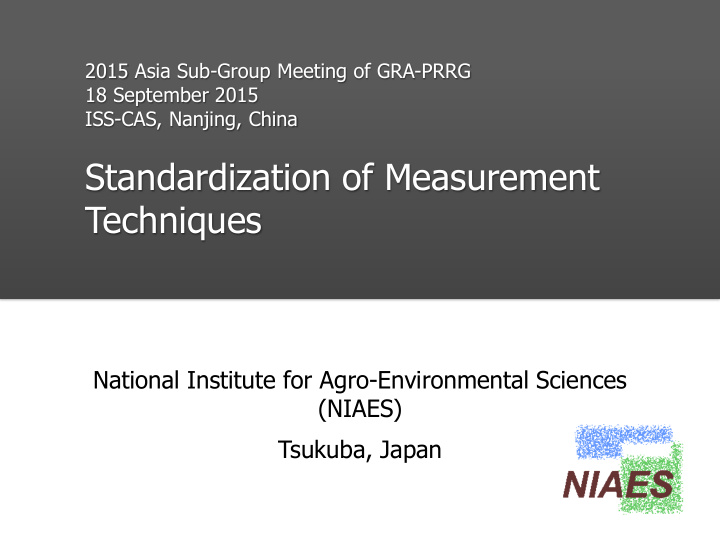



2015 Asia Sub-Group Meeting of GRA-PRRG 18 September 2015 ISS-CAS, Nanjing, China Standardization of Measurement Techniques National Institute for Agro-Environmental Sciences (NIAES) Tsukuba, Japan
Progress until 2014 2010 2012 2013 2013 2014 RECOs of GRA-PRRG A method MIRSA-2 Contents of guidelines activities paper project guidelines made started published started confirmed tentatively Greenhouse Gas M itigation in I rrigated R ice Paddies in Appropriate S outheast A sia (Part 2 ): Field time of day Demonstration and Consolidation and frequency of Procedures (Minamikawa et al., 2012) International research project funded by Japanese government Around 10AM until 2017 among six Asian research institutes ( financial support for GRA-PRRG activities)
Measurement Guidelines just published Preface Table of contents Recommendations Experimental design Chamber design Gas sampling Gas analysis Data processing Auxiliary measurements Evolving issues 1. Experimental design 2. Chamber design 3. Gas sampling 4. Gas analysis 5. Data processing 6. Auxiliary measurements References Appendices Officially published online on 11 Aug. Available from NIAES’s webpage: http://www.niaes.affrc.go.jp/techdoc/mirsa_guidelines.pdf
Measurement Guidelines: Contents Totally 76 pages, Minimum requirements are summarized as “Recommendations” at the beginning, Practical and technical methods for each step of measurements are described with photos/illustrations and scientific bases, Some unsolved problems are discussed as “evolving issues”. Recommendations Gas sampling
Evolving issues: toward near-future improvement (1/2) Issue Current status and prospects Equipment For various reasons, it is not always possible to procure the required availability equipment, so measurement procedures need to be flexible and, thus, may not be uniform . Standard It is sometimes difficult to obtain certified standard gases. gases If necessary, standards of the required concentrations can be produced by diluting high-concentration standard gas with an inert gas (He or N 2 ) with proper checking of the accuracy of the dilution. Compressed air can be used as a working standard gas after determination of the target gas concentrations. Chamber Chamber transparency (or opacity) remains an open question. transparency Both transparent and opaque materials have advantages and disadvantages , but which type of material is used often depends on what is available.
Evolving issues: toward near-future improvement (2/2) Issue Current status and prospects Chamber The area covered by each chamber (i.e., its footprint) and the number area and of chambers that should be deployed within a plot depend on the number of required measurement accuracy . chambers The larger the chamber area and the greater the number of within a plot chambers deployed, the more reliable the gas flux data will be. However, practically, the chamber area and the number of chambers may be limited by the number of people available to carry out the measurements. There is no consensus as to what percentage of the plot area should be covered to obtain a representative gas flux value. Interpolation Insufficient gas flux data collected during drainage or after N to fill gaps in fertilization may lead to considerable over- or underestimation of the gas flux total emissions. data Any such gaps in the measurements should be recorded. The gaps may be filled by interpolation by making some reasonable assumptions.
Research gap filling (1/2)
Research gap filling (2/2) Dataset from the whole rice season • Blue: 2012DS • Orange: 2012WS • Red: 2013DS • No diurnal variation in N 2 O flux • Weller et al. (2015) Minamikawa et al. (2012) Site Philippines Japan Time of daily mean flux 7:00-9:00 & 17:00-19:00 8:00 – 11:59 & 18:00 – 21:59 Typical observable stage Early stage with low leaf area After heading stage
Future Works Subject 2 : Development of the guidelines for implementing MRV 1. Collection of scientific information on MRV (from Minamikawa) 2. Analysis of social and natural limitation factors of AWD (from Yamaguchi) 3. Developing online database for data exchange and site information (from Sudo) FY2013 FY2014 FY2015 FY2016 FY2017 M guidelines R & V guidelines Integration Social study Writing papers Online-database development & application
Recommend
More recommend